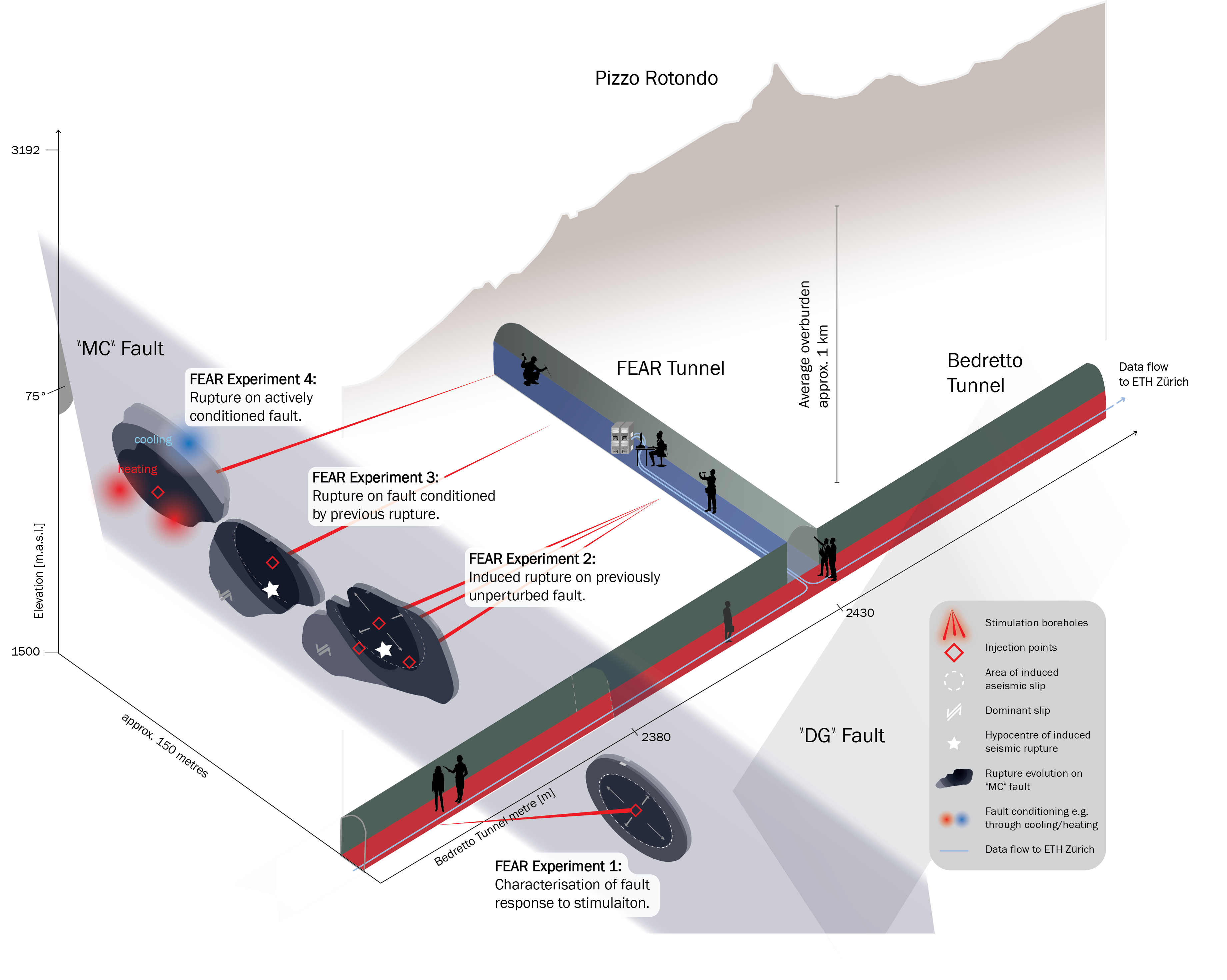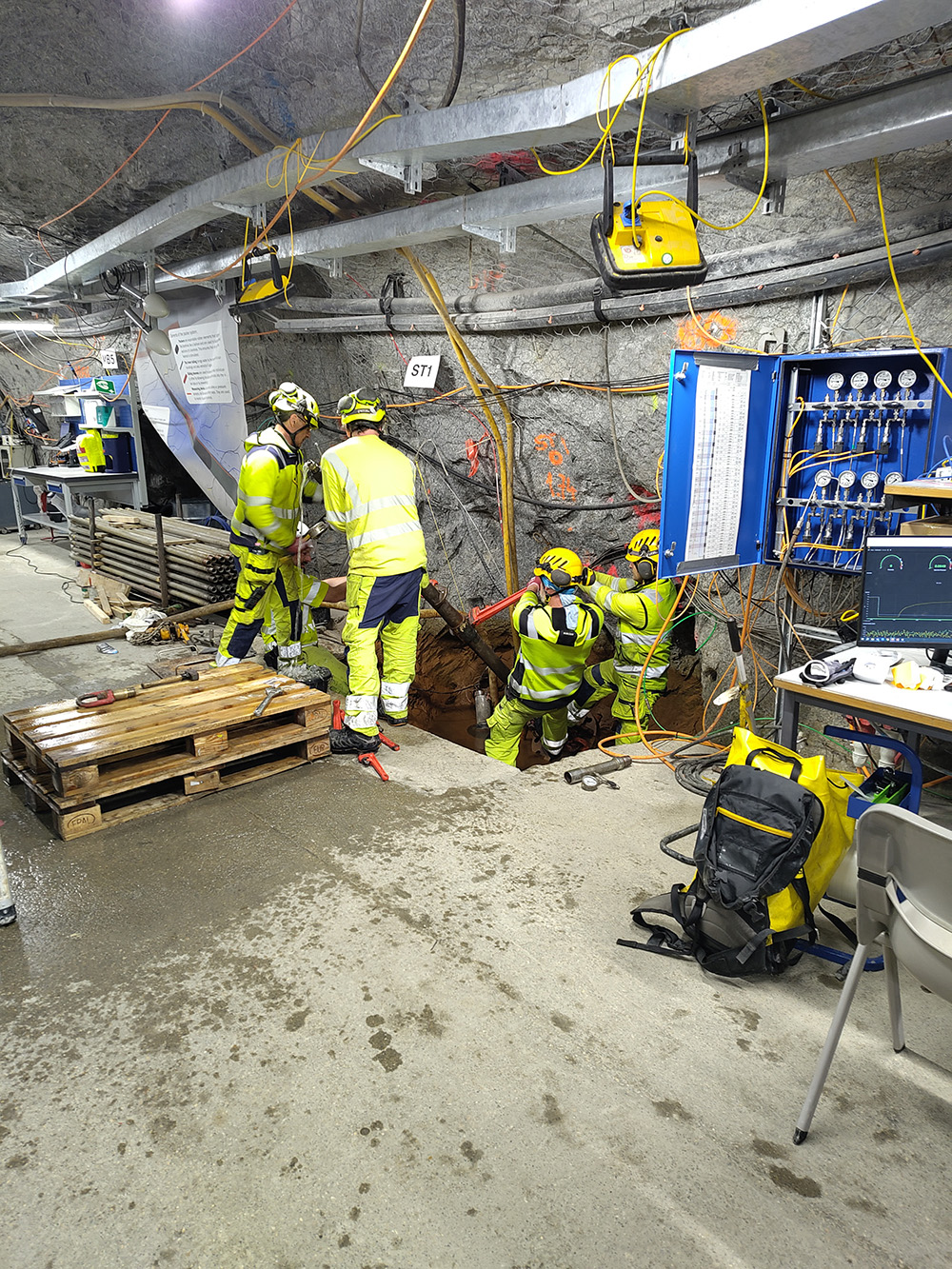Second M0 experiment finished successfully
The second multi-day hydraulic stimulation conducted in the framework of FEAR was finished successfully at the end of August. A team of about ten people monitored a stimulation lasting for about three days, injecting water with a pressure of 20 MPa.
As anticipated, the injection triggered a high level of microseismicity: our real-time monitoring workflow detected several thousand tiny earthquakes. The two largest events reached a magnitude of around -1.0. This is equivalent to when rocks rupture in an area of one meter in diameter and move by up to 1 millimetre.
The experiment was conducted according to a previously designed protocol. With the new remote-control system, the entire experiment and monitoring could be conducted from a control room at ETH Zurich and the Barracke near the tunnel entrance in Ronco, with no one in the tunnel.
Now, the team is busy analysing the rich data set and preparing for the next experiments in November and December 2024.
Continuation of the M0 experiment
Following the successful M0 experiment in late April, a new extended hydraulic stimulation experiment is scheduled for late August. The objective is to replicate the results of the previous test, which triggered, as planned, an earthquake with a magnitude of about 0. The now schedulded experiment will involve a shorter, high-pressure stimulation (20 MPa) lasting a maximum of three days.
This approach will help determine if the seismicity characteristics remain consistent with or differ from the prior experiment, which involved several days of rock mass preconditioning at intermediate pressures (15 MPa).
The potential risks associated with these experiments are considered low. However, safety measures have been implemented, including remote-controlled pump circuits that allow the experiments to be conducted without personnel in the tunnel. Additionally, predefined thresholds for magnitude and ground motion will trigger the halt of the injection to avoid any dangerous ground motions to occur.
First long-term injection experiment (M0) successfully finished
At the end of April, the BedrettoLab team successfully conducted their first long-term injection experiment in the framework of the FEAR project. The M0 experiment lasted several days aiming to generate an earthquake of about magnitude 0 and monitor it from close by.
Following a week of preliminary tests and a four-day preparation phase, high-pressure hydraulic stimulation commenced, with around-the-clock real-time monitoring. The target earthquake occurred at 6 o'clock in the morning of 30 April, somewhat earlier than expected, achieving the experiment's goal and prompting the cessation of injection.
In an earthquake of this magnitude, the rock moves along a plane by about 1-2 millimeters over an area of roughly 5-by-5 meters. This rupture lasts only a millisecond and radiates seismic waves, which our sensitive monitoring arrays are designed to capture. The waves are much too weak to be felt at the surface.
The seismology team uses these detailed recordings of such a small event to study the physical processes that occur during an earthquake. A better understanding of such processes may lead to improvements in earthquake risk mitigation and management in the future. It also contributes to better management of induced seismicity related to deep geothermal energy projects. Currently, the team is analyzing and modeling the collected data, and preparing the next long-term injection scheduled for autumn.
First long-term injection experiment starting in mid-April

The BedrettoLab team is embarking on a new phase of experiments. As part of the FEAR project, a sequence of hydraulic stimulation experiments will start in mid-April. Leveraging on insights gained from the VALTER experiments, the team plans continued injections for an extended period of two to four days, allowing the reactivation and extension of the fracture network of the reservoir created in past experiments. Scientifically, the team is focusing mainly on the seismic response of the reservoir and aims to scale up the seismicity to larger events than previously observed.
In past experiments, the largest observed micro-earthquake was about a magnitude -2; in the upcoming M0 experiment, the team strives to reach about a magnitude 0. Such an event is about 100 times larger in amplitude and releases about 1´000 times more energy than a magnitude -2. Such an event would rupture a patch of about two by two meters by about one centimetre, allowing us to study when and where such a micro-earthquake starts, how it ruptures, and when it stops. For comparison, a natural earthquake of magnitude 6 that occurs in Switzerland every 50 to 150 years ruptures a patch of 10 by 10 kilometres by one meter, releasing about 1 billion times more energy.
Magnitude 0 events have already occurred naturally in the vicinity of the tunnel, and such micro-earthquakes remain about 100 to 1’000 times too small to be felt by people in the Bedretto Valley at a distance of several kilometres. The likelihood of induced larger events that could be detected in the Bedretto Valley remains extremely low. However, even micro-earthquakes of magnitude zero to one can be felt if experienced within a few meters or tens of meters of them. To eliminate even the smallest risk to people in the tunnel, these experiments will not only be very closely monitored, but they will also for the first time be fully remote controlled. During the main injection, no people will be allowed in the tunnel. This remote-control capability will be even more important later in the FEAR project when patches of 10 meters are the target size.
During the main part of the experiment, about twenty dedicated members of the BedrettoLab team will be working in 24/7 shifts over a period of one week. Their primary task will be to monitor the pressure, flow rate, deformation, and seismicity behaviour in real-time. The geobiological and geochemical response of the reservoir will also be closely monitored, for example, to detect pre-cursors before larger ruptures. As implemented for previous experiments, two traffic light systems regulate the experiment, and if the observed vibrations or magnitude exceed pre-defined thresholds, the experiment will be ended immediately and bleed-off initiated; past experiments have shown that seismicity will then within minutes to hours decrease strongly.


